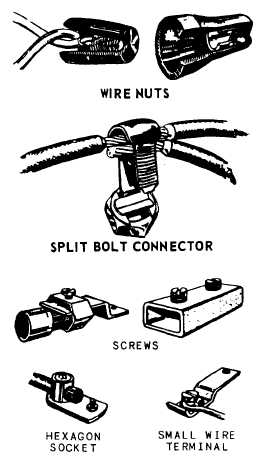for connecting rigid metal conduit are shown in
figure 9-15, view A. The use of rigid conduit
involves a good deal of cutting, bending, and
threading of lengths. An ordinary hacksaw or
special wheel pipe cutter is used for cutting, while
a ratchet type of mechanical die is used for thread-
cutting conduit pipes. Bending of pipes can be
undertaken both manually, using a bending tool
commonly called a hickey, and hydraulically. A
hydraulic bender is recommended for making
smooth and accurate bends.
CONDULETS (fig. 9-15, view A (2)) are a
convenient way of making bends, especially in
conduit that will be exposed to the elements. They
are heavily used on sharp corners and also to
reduce the number of bends made in a run of
conduit.
Another type of rigid conduit approved for
use by NAVFAC is the polyvinyl chloride (PVC)
pipe. This now popular plastic conduit is specially
suitable for use in areas where corrosion of metal
conduits has been a problem. Some of the
advantages of PVC conduit are as follows: light
handling weight,
ease of installation, and
leakproof joints.
This conduit is primarily
intended for underground wire and cable raceway
use and is made in two forms. Type I is designed
for concrete encasement, and Type II is designed
for direct earth burial. Rigid plastic conduit and
fittings are joined together by a solvent-type
adhesive welding process. It also comes in sizes
of 1/2 to 6 in. in diameter. PVC fittings are also
available from the manufacturer. (For more
information on PVC fittings, refer to Article 370
of the NEC®.)
THIN-WALL CONDUIT.— Electric metallic
tubing (EMT) or thin-wall conduit, as it is better
known, is a type of conduit with a wall thickness
quite a bit less than the rigid conduit. It is made
in sizes from 1/2 to 2 in. in diameter. Thin-wall
conduit cannot be threaded; therefore, special
types of fittings (fig. 9-15, view B) must be used
for connecting pipe to pipe to boxes.
FLEXIBLE CONDUIT.— Flexible conduit
(fig. 9-15, view C), also called Greenfield, is a
spirally wrapped metal band wound upon itself
and interlocking in such a manner as to provide
a round cross section of high mechanical strength
and flexibility. It is used where rigid conduit
would not be feasible to install and requires no
elbow fittings. It is made in sizes from 1/2 to
3 in. in diameter. Greenfield is available in two
types: the plain or standard unfinished-metal type
and a moisture-resistant type called sealtite, which
has a plastic or latex jacket. The moisture-resistant
type is not intended for general use but only
for connecting motors or portable equipment in
damp or wet locations and where flexibility of
connections is desired.
Wire Connectors
Figure 9-16 shows various types of connectors
that are used to join or splice conductors. The type
used will depend on the type of installation and
the wire size. Most connectors operate on the
same principle, that of gripping or pressing the
conductors together. WIRE NUTS are used
extensively for connecting insulated single
conductors installed inside of buildings.
Outlet Boxes
OUTLET BOXES bind together the elements
of a conduit or cable system in a continuous
Figure 9-16.-Types of cable and wire connectors.
9-12


